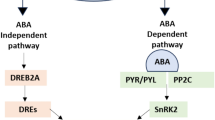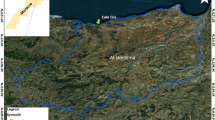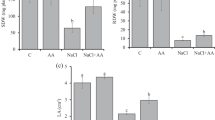Abstract
Salinity is one of the major abiotic stresses that cause retarded plant growth and crop production. It has been reported that harmful effects of salinity could be managed by application of salt-tolerant plant growth-promoting (PGP) bacteria. In this study, eight salt-tolerant bacteria were selected from an array of 150 cultures, based on salt-tolerant properties. All the isolates were identified based on 16S rRNA gene sequencing and subjected to different PGP properties. The results showed the production of indole acetic acid (28.83–62.35 µg/ml), ammonia (35.49–67.48 µg/ml), phosphate solubilization (1.45–3.42 µg/ml), and siderophores. Further, these isolates were evaluated in pot studies on their response in Cucumis sativus plants against 100 mM salinity stress and without salinity stress (normal water) along with uninoculated controls. The results revealed that bacterized seeds had enhanced plant growth parameters and there was a corresponding increase in biomass in both conditions compared to control plants. The maximum enhancement in root and shoot length under normal condition was 54.6% (SBR-4) and 69.3% (SBS-19), whereas under saline conditions it was 42.3% (SBR-5) and 100.4% (SBS-18), respectively. Further, the inoculated seedlings maximum enhanced chlorophyll a (SBS-3; 50.6% and SBR-4; 45.4%) and chlorophyll b (SBR-1; 83.6% and SBS-3; 209.6%), proline (SBS-18; 62.0% and SBR-1; 32.8%), total phenol (SBR-1; 48.2% and SBR-5; 67.8%), ascorbic acid (SBS-2; 118.6% and SBR-1; 22.4%), and shoot and root N and P contents (twofold to threefold) under both normal and saline conditions. Among the eight isolates, isolates SBS-19, SRB-5, SBS-18, and SBR-4 improved plant growth and other parameters under both conditions in C. sativus plants. Therefore, it is suggested that these salt-tolerant PGP bacteria may be used for cultivation of C. sativus in salinized agricultural lands.






Similar content being viewed by others
References
Abbasi MK, Sharif S, Kazmi M, Sultan T, Aslam M (2011) Isolation of plant growth promoting rhizobacteria from wheat rhizosphere and their effect on improving growth, yield and nutrient uptake of plants. Plant Biosyst 145:159–168
Abdelgawad KF, El-Mogy MM, Mohamed MIA, Garchery C, Stevens RG (2019) Increasing ascorbic acid content and salinity tolerance of cherry tomato plants by suppressed expression of the ascorbate oxidase gene. Agronomy 9:51
Abdul Qados AMS (2011) Effect of salt stress on plant growth and metabolism of bean plant Vicia faba (L.). J Saudi Soc Agric Sci 10:7–15
Ahanger MA, Tomar NS, Tittal M, Argal S, Agarwal RM (2017) Plant growth under water/salt stress: ROS production; antioxidants and significance of added potassium under such conditions. Physiol Mol Biol Plants 23:731–744
Akbarimoghaddam H, Galavi M, Ghanbari A, Panjehkeh N (2011) Salinity effects on seed germination and seedling growth of bread wheat cultivars. Trakia J Sci 9:43–50
Altschul SF, Maddan TL, Schaffer AA, Zang J, Zang Z, Miller W, Lipman DJ (1997) Gapped BLAST and PSI-BLAST: a new generation of protein database search programmes. Nucleic Acids Res 25:3389–3402
Amaresan N, Kumar K, Sureshbabu K, Madhuri K (2014) Plant growth-promoting potential of bacteria isolated from active volcano sites of Barren Island, India. Lett Appl Microbiol 58:130–137
Baethgen WE, Alley MM (1989) A manual colorimetric procedure for measuring ammonium nitrogen in soil and plant. Commun Soil Sci Plant Anal 20:961–969
Baha N, Bekki A (2015) An approach of improving plant salt tolerance of Lucerne (Medicago sativa) grown under salt stress: use of bio-inoculants. J Plant Growth Regul 34:169–182
Bettaieb I, Hamrouni-Sellami I, Bourgou S, Limam F, Marzouk B (2011) Drought effects on polyphenol composition and antioxidant activities in aerial parts of Salvia officinalis L. Acta Physiol Plant 33:1103–1111
Bharti N, Pandey SS, Barnawal D, Patel VK, Kalra A (2016) Plant growth promoting rhizobacteria Dietzia natronolimnaea modulates the expression of stress responsive genes providing protection of wheat from salinity stress. Sci Rep 6:34768
Bharti N, Yadav D, Barnawal D, Maji D, Kalra A (2013) Exiguobacterium oxidotolerans, a halotolerant plant growth promoting rhizobacteria, improves yield and content of secondary metabolites in Bacopa monnieri (L.) Pennell under primary and secondary salt stress. World J Microbiol Biotechnol 29:379–387
Cai YZ, Luo Q, Sun M, Corke H (2004) Antioxidant activity and phenolic compounds of 112 traditional Chinese medicinal plants associated with anticancer. Life Sci 74:2157–2184
Cappuccino JC, Sherman N (1992) Microbiology: a laboratory manual, 3rd edn. Benjamin/Cummings Pub. Co., New York, pp 125–179
Castric PA (1975) Hydrogen cyanide, a secondary metabolite of Pseudomonas aeruginosa. Can J Microbiol 21:613–618
Coutinho FP, Felix WP, Yano-Melo AM (2012) Solubilization of phosphates in vitro by Aspergillus spp. and Penicillium spp. Ecol Eng 42:85–89
Ge H, Zhang F (2019) Growth-promoting ability of Rhodopseudomonas palustris G5 and its effect on induced resistance in cucumber against salt stress. J Plant Growth Regul 38:180–188
Gordon SA, Paleg LG (1957) Quantitative measurement of indole acetic acid. Physiol Plant Pathol 10:347–348
Hmaeid N, Wali M, Ben Mahmoud QM, Pueyo JJ, Ghnaya T, Abdelly C (2019) Efficient rhizobacteria promote growth and alleviate NaCl-induced stress in the plant species Sulla carnosa. Appl Soil Ecol 133:104–113
Islam MR, Madhaiyan M, Boruah HPD, Yim W, Lee G, Saravanan VS, Fu Q, Hu H, Sa T (2009) Characterization of plant growth-promoting traits of free-living diazotrophic bacteria and their inoculation effects on growth and nitrogen uptake of crop plants. J Microbiol Biotechnol 19:1213–1222
Jackson ML (1967) Soil chemical analysis. Prentice Hall Inc., Engle Wood Cliff
Jackson ML (1973) Soil chemical analysis. Prentice Hall of India (P) Ltd., New Delhi
Jay PV, Janardan Y, Kavindra NT, Ashok K (2013) Effect of indigenous Mesorhizobium spp. and plant growth promoting rhizobacteria on yields and nutrients uptake of chickpea (Cicer arietinum L.) under sustainable agriculture. Ecol Eng 51:282–286
Kang SM, Khan AL, Waqas M, You YH, Kim JH, Kim JG, Hamayun M, Lee IJ (2014) Plant growth-promoting rhizobacteria reduce adverse effects of salinity and osmotic stress by regulating phytohormones and antioxidants in Cucumis sativus. J Plant Interact 9:673–682
Kato N, Esaka M (1999) Changes in ascorbate oxidase gene expression and ascorbate levels in cell division and cell elongation in tobacco cells. Physiol Plant 105:321–329
Khalifa AYZ, Alsyeeh AM, Almalki MA, Saleh FA (2016) Characterization of the plant growth promoting bacterium, Enterobacter cloacae MSR1, isolated from roots of non-nodulating Medicago sativa. Saudi J Biol Sci 23:79–86
Khan F, Ahmed KBM, Shariq M, Siddiqui MA (2019) Potentiality of plant growth-promoting rhizobacteria in easing of soil salinity and environmental sustainability. In: Akhtar M (ed) Salt stress, microbes, and plant interactions: causes and solution. Springer, Singapore, pp 21–58
Khan MA, Gemenet DC, Villordon A (2016) Root system architecture and abiotic stress tolerance: current knowledge in root and tuber crops. Front Plant Sci 7:1584
Khanna K, Jamwal VL, Sharma A, Gandhi SG, Ohri P, Bhardwaj R, Al-Huqail AA, Siddiqui MH, Ali HM, Ahmad P (2019a) Supplementation with plant growth promoting rhizobacteria (PGPR) alleviates cadmium toxicity in Solanum lycopersicum by modulating the expression of secondary metabolites. Chemosphere 230:628–639
Khanna K, Jamwal VL, Kohli SK, Gandhi SG, Ohri P, Bhardwaj R, Wijaya L, Alyemeni MN, Ahmad P (2019b) Role of plant growth promoting bacteria (PGPRs) as biocontrol agents of Meloidogyne incognita through improved plant defense of Lycopersicon esculentum. Plant Soil 463:325–345
Khanna K, Jamwal VL, Sharma A, Gandhi SG, Ohri P, Bhardwaj R, Al-Huqail AA, Siddiqui MH, Marraiki N, Ahmad P (2019c) Evaluation of the role of rhizobacteria in controlling root-knot nematode infection in Lycopersicon esculentum plants by modulation in the secondary metabolite profiles. AoB Plants 11:plz069
Khanna K, Sharma A, Ohri P, Bhardwaj R, Abd_Allah EF, Hashem A, Ahmad P (2019d) Impact of plant growth promoting rhizobacteria in the rrchestration of Lycopersicon esculentum Mill. resistance to plant parasitic nematodes: a metabolomic approach to evaluate defense responses under field conditions. Biomolecules 9:676
Kumar D, Al Hassan M, Naranjo MA, Agrawal V, Boscaiu M, Vicente O (2017a) Effects of salinity and drought on growth, ionic relations, compatible solutes and activation of antioxidant systems in oleander (Nerium oleander L.). PLoS One 12:e0185017
Kumar K, Amaresan N, Madhuri K (2017b) Alleviation of the adverse effect of salinity stress by inoculation of plant growth promoting rhizobacteria isolated from hot humid tropical climate. Ecol Eng 102:361–366
Li Y, Shi H, Zhang H, Chen S (2019) Amelioration of drought effects in wheat and cucumber by the combined application of super absorbent polymer and potential biofertilizer. Peer J 7:e6073
Numan M, Bashir S, Khan Y, Mumtaz R, Shinwari ZK, Khan AL, Khan A, Al-Harrasi A (2018) Plant growth promoting bacteria as an alternative strategy for salt tolerance in plants: a review. Microbiol Res 209:21–32
Oberbacher MF, Vines HM (1963) Spectrophotometric assay of ascorbic acid oxidase. Nature 197:1203–1204
Orhan F (2016) Alleviation of salt stress by halotolerant and halophilic plant growth-promoting bacteria in wheat (Triticum aestivum). Braz J Microbiol 47:621–627
Panda D, Sharma SG, Sarkar RK (2008) Chlorophyll fluorescence parameters, CO2 photosynthetic rate and regeneration capacity as a result of complete submergence and subsequent re-emergence in rice (Oryza sativa L.). Aquat Bot 88:127–133
Pandey P, Irulappan V, Bagavathiannan MV, Senthilkumar M (2017) Impact of combined abiotic and biotic stresses on plant growth and avenues for crop improvement by exploiting physio-morphological traits. Front Plant Sci 8:537
Panwar M, Tewari R, Nayyar H (2016) Native halo-tolerant plant growth promoting rhizobacteria Enterococcus and Pantoea sp. improve seed yield of Mungbean (Vigna radiata L.) under soil salinity by reducing sodium uptake and stress injury. Physiol Mol Biol Plants 22:445–459
Patel S, Jinal HN, Amaresan N (2017) Isolation and characterization of drought resistance bacteria for plant growth promoting properties and their effect on chilli (Capsicum annuum) seedling under salt stress. Biocatal Agric Biotechnol 12:85–89
Patel VK, Srivastava R, Sharma A, Srivastava AK, Singh S, Srivastava AK, Kashyap PL, Chakdar H, Pandiyan K, Kalra A, Saxena AK (2018) Halotolerant Exiguobacterium profundum PHM11 tolerate salinity by accumulating L-proline and fine-tuning gene expression profiles of related metabolic pathways. Front Microbiol 9:423
Paul D, Lade H (2014) Plant-growth-promoting rhizobacteria to improve crop growth in saline soils: a review. Agron Sustain Dev 34:737–752
Ploegman J, Bierhuizen CF (1970) Salt tolerance in cucumber. Bedrijfsontwikkeling Editie Tuinbouw 1:32–39
Prittesh P, Avnika P, Kinjal P, Jinal HN, Saktivel K, Amaresan N (2020) Amelioration effect of salt-tolerant plant growth-promoting bacteria on growth and physiological properties of rice (Oryza sativa) under salt-stressed conditions. Arch Microbiol. https://doi.org/10.1007/s00203-020-01962-4
Parray JA, Jan S, Kamili AN, Qadri RA, Egamberdieva D, Ahmad P (2016) Current perspectives on plant growth promoting rhizobacteria. J Plant Growth Regul 35:877–902
Ramesh A, Sharma SK, Sharma MP, Yadav N, Joshi OP (2014) Plant growth-promoting traits in Enterobacter cloacae subsp. dissolvens MDSR9 isolated from soybean rhizosphere and its impact on growth and nutrition of soybean and wheat upon inoculation. Agric Res 3:53–66
Sambrook J, Fritschi EF, Maniatis T (1989) Molecular cloning: a laboratory manual. Cold Spring Harbor Laboratory Press, New York
Sayed E, Ahmed HES, Baziad SAM, Basaba RAAS (2015) Application of exogenous ascorbic acid on tomato (Solanum lycopersicum L.) seeds under NaCl salinity stress. Int J Curr Res Biosci Plant Biol 2:33–46
Schwyn B, Neilands JB (1987) Universal chemical assay for the detection and determination of siderophores. Anal Biochem 160:47–56
Shahid SA, Zaman M, Heng L (2018) Introduction to soil salinity, sodicity and diagnostics techniques. In: Zaman M, Shahid SA, Heng L (eds) Guideline for salinity assessment, mitigation and adaptation using nuclear and related techniques. Springer, Cham, pp 1–42
Singh JS, Kaushal S, Kumar A, Vimal SR, Gupta VK (2016) Book review: microbial inoculants in sustainable agricultural productivity—Vol II: functional application. Front Microbiol 7:2015
Sukweenadhi J, Balusamy SR, Kim YJ, Lee CH, Kim YJ, Koh SC, Yang DC (2018) A growth-promoting bacteria, Paenibacillus yonginensis DCY84T enhanced salt stress tolerance by activating defense-related systems in Panax ginseng. Front Plant Sci 9:813
Tajini F, Mustapha TM, Drevon JJ (2012) Combined inoculation with Glomus intraradices and Rhizobium tropici CIAT899 increases phosphorus use efficiency for symbiotic nitrogen fixation in common bean (Phaseolus vulgaris L.). Saudi J Biol Sci 19:157–163
Torre-Ruiza NDL, Ruiz-Valdiviezob VM, Rincón-Molinab CI, Rodríguez-Mendiolaa M, Arias-Castroa C, Gutiérrez-Micelib FA, Palomeque-Dominguezb H, Rincón-Rosales R (2016) Effect of plant growth-promoting bacteria on the growth and fructan production of Agave americana L. Braz J Microbiol 47:587–596
Ullah A, Mushtaq H, Fahad Sh, Hakim SA, Chaudhary HJ (2017) Plant growth promoting potential of bacterial endophytes in novel association with Olea ferruginea and Withania coagulans. Microbiology 86:119–127
Upadhyay SK, Singh DP (2015) Effect of salt-tolerant plant growth-promoting rhizobacteria on wheat plants and soil health in a saline environment. Plant Biol 17:288–293
Upadhyay SK, Singh JS, Saxena AK, Singh DP (2012) Impact of PGPR inoculation on growth and antioxidant status of wheat under saline conditions. Plant Biol 14:605–611
Usanmaz S, Abak K (2019) Plant growth and yield of cucumber plants grafted on different commercial and local rootstocks grown under salinity stress. Saudi J Biol Sci 26:1134–1139
Verma JP, Yadav J, Tiwari KN, Kumar A (2013) Effect of indigenous Mesorhizobium spp. and plant growth promoting rhizobacteria on yields and nutrients uptake of chickpea (Cicer arietinum L.) under sustainable agriculture. Ecol Eng 51:282–286
Vimal SR, Patel VK, Singh JS (2019) Plant growth promoting Curtobacterium albidum strain SRV4: an agriculturally important microbe to alleviate salinity stress in paddy plants. Ecol Indic 105:553–562
Wolf B (1982) The comprehensive system of leaf analysis and its use for diagnosing crop nutrient status. Commun Soil Sci Plant Anal 3:1035–1059
Yamamoto A, Bhuiyan MN, Waditee R, Tanaka Y, Esaka M, Oba K, Jagendorf AT, Takabe T (2005) Suppressed expression of the apoplastic ascorbate oxidase gene increases salt tolerance in tobacco and Arabidopsis plants. J Exp Bot 56:1785–1796
Yoo SJ, Weon HY, Song J, Sang MK (2019) Induced tolerance to salinity stress by halotolerant bacteria Bacillus aryabhattai H19-1 and B. mesonae H20-5 in tomato plants. J Microbiol Biotechnol 29:1124–1136
Zahid M, Abbasi MK, Hameed S, Rahim N (2015) Isolation and identification of indigenous plant growth promoting rhizobacteria from Himalayan region of Kashmir and their effect on improving growth and nutrient contents of maize (Zea mays L.). Front Microbiol 6:207
Zhou T, Chen D, Li C, Sun Q, Li L, Liu F, Shen Q, Shen B (2012) Isolation and characterization of Pseudomonas brassicacearum J12 as an antagonist against Ralstonia solanacearum and identification of its antimicrobial components. Microbiol Res 167:388–394
Acknowledgements
The authors thank Head, Department of Biosciences, Veer Narmad South Gujarat University, Surat, and Uka Tarsadia University management, and Director, C.G. Bhakta Institute of Biotechnology, for constant support and providing necessary facilities to carry out the work.
Author information
Authors and Affiliations
Contributions
NA-Conceived and designed the experiments; VPK, HNJ-Performed all experiments, statistical analysis, tables and figures; VPK, NA wrote the paper.
Corresponding author
Ethics declarations
Conflict of interest
The authors declare that they have no conflict of interest.
Additional information
Publisher's Note
Springer Nature remains neutral with regard to jurisdictional claims in published maps and institutional affiliations.
Rights and permissions
About this article
Cite this article
Kartik, V.P., Jinal, H.N. & Amaresan, N. Inoculation of Cucumber (Cucumis sativus L.) Seedlings with Salt-Tolerant Plant Growth Promoting Bacteria Improves Nutrient Uptake, Plant Attributes and Physiological Profiles. J Plant Growth Regul 40, 1728–1740 (2021). https://doi.org/10.1007/s00344-020-10226-w
Received:
Accepted:
Published:
Issue Date:
DOI: https://doi.org/10.1007/s00344-020-10226-w




